An Analysis of Ethical Issues in Social Policy: A Report
VerifiedAdded on 2020/07/22
|7
|1727
|104
Report
AI Summary
This report delves into the ethical dimensions of social policy, specifically focusing on ethical dilemmas. The report begins with an introduction to ethics, defining its meaning and providing real-world examples to illustrate ethical considerations. It identifies a key ethical dilemma, specifically in the context of health and social care, that of surrogacy, and explores the key issues surrounding it. The report then examines relevant legislation and policies related to the chosen dilemma, providing a legal framework for understanding the ethical issues. Further, it compares different views on the ethical dilemma, offering diverse perspectives on the subject. Finally, the report evaluates the various viewpoints and draws its own conclusions, synthesizing the information to provide a comprehensive analysis of the ethical issues involved. The report concludes with a discussion of the ethical considerations and the implications for individuals and society.
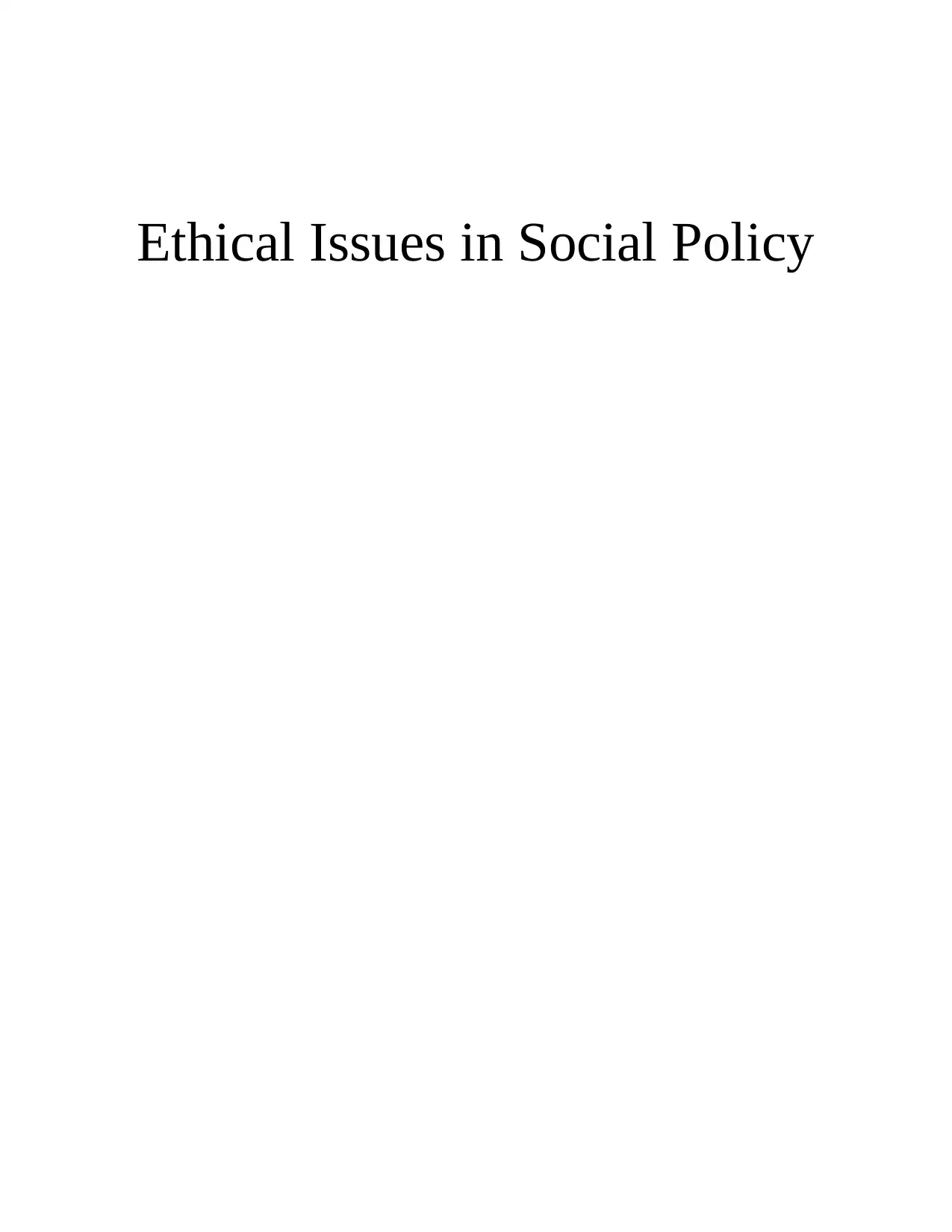
Ethical Issues in Social Policy
Paraphrase This Document
Need a fresh take? Get an instant paraphrase of this document with our AI Paraphraser
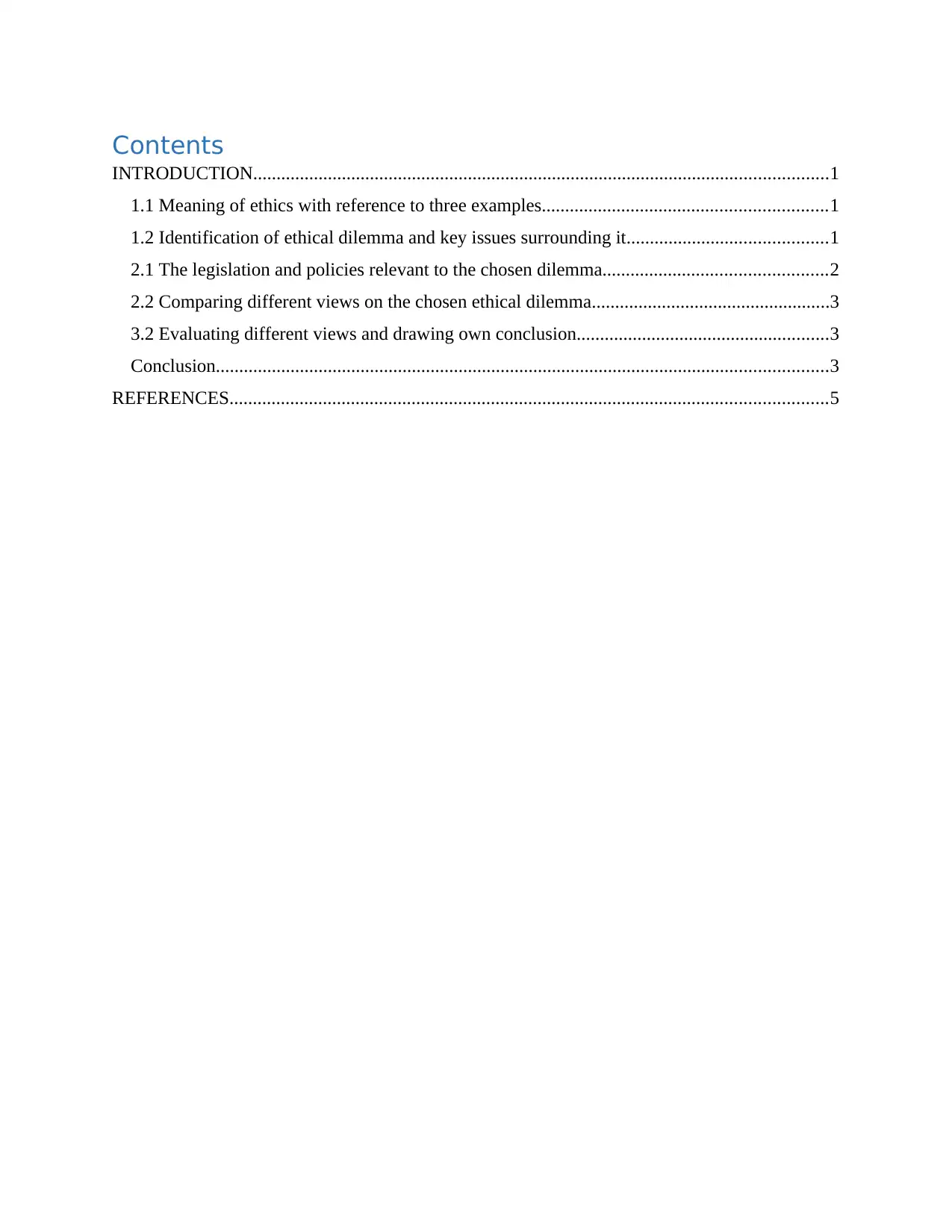
Contents
INTRODUCTION...........................................................................................................................1
1.1 Meaning of ethics with reference to three examples.............................................................1
1.2 Identification of ethical dilemma and key issues surrounding it...........................................1
2.1 The legislation and policies relevant to the chosen dilemma................................................2
2.2 Comparing different views on the chosen ethical dilemma...................................................3
3.2 Evaluating different views and drawing own conclusion......................................................3
Conclusion...................................................................................................................................3
REFERENCES................................................................................................................................5
INTRODUCTION...........................................................................................................................1
1.1 Meaning of ethics with reference to three examples.............................................................1
1.2 Identification of ethical dilemma and key issues surrounding it...........................................1
2.1 The legislation and policies relevant to the chosen dilemma................................................2
2.2 Comparing different views on the chosen ethical dilemma...................................................3
3.2 Evaluating different views and drawing own conclusion......................................................3
Conclusion...................................................................................................................................3
REFERENCES................................................................................................................................5
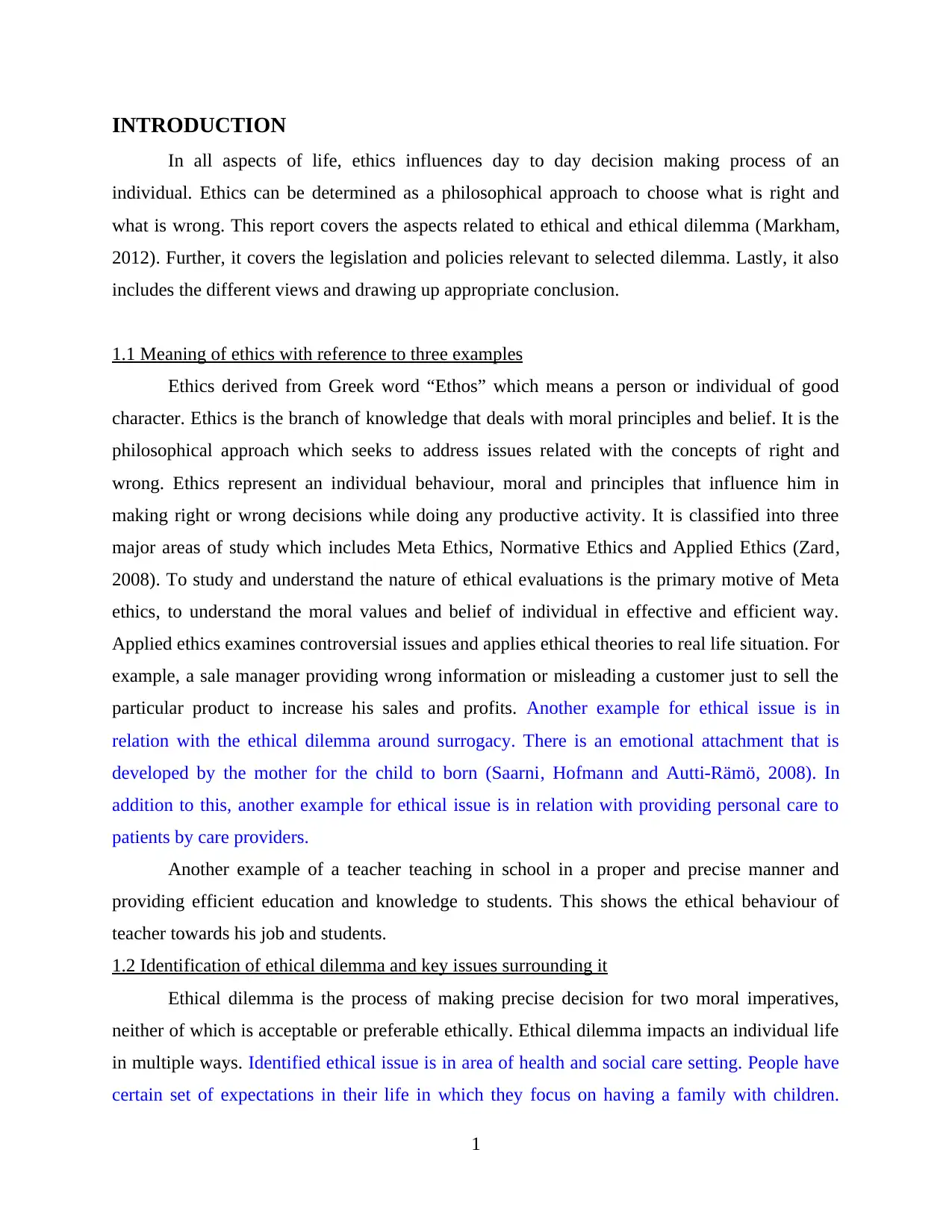
INTRODUCTION
In all aspects of life, ethics influences day to day decision making process of an
individual. Ethics can be determined as a philosophical approach to choose what is right and
what is wrong. This report covers the aspects related to ethical and ethical dilemma (Markham,
2012). Further, it covers the legislation and policies relevant to selected dilemma. Lastly, it also
includes the different views and drawing up appropriate conclusion.
1.1 Meaning of ethics with reference to three examples
Ethics derived from Greek word “Ethos” which means a person or individual of good
character. Ethics is the branch of knowledge that deals with moral principles and belief. It is the
philosophical approach which seeks to address issues related with the concepts of right and
wrong. Ethics represent an individual behaviour, moral and principles that influence him in
making right or wrong decisions while doing any productive activity. It is classified into three
major areas of study which includes Meta Ethics, Normative Ethics and Applied Ethics (Zard,
2008). To study and understand the nature of ethical evaluations is the primary motive of Meta
ethics, to understand the moral values and belief of individual in effective and efficient way.
Applied ethics examines controversial issues and applies ethical theories to real life situation. For
example, a sale manager providing wrong information or misleading a customer just to sell the
particular product to increase his sales and profits. Another example for ethical issue is in
relation with the ethical dilemma around surrogacy. There is an emotional attachment that is
developed by the mother for the child to born (Saarni, Hofmann and Autti-Rämö, 2008). In
addition to this, another example for ethical issue is in relation with providing personal care to
patients by care providers.
Another example of a teacher teaching in school in a proper and precise manner and
providing efficient education and knowledge to students. This shows the ethical behaviour of
teacher towards his job and students.
1.2 Identification of ethical dilemma and key issues surrounding it
Ethical dilemma is the process of making precise decision for two moral imperatives,
neither of which is acceptable or preferable ethically. Ethical dilemma impacts an individual life
in multiple ways. Identified ethical issue is in area of health and social care setting. People have
certain set of expectations in their life in which they focus on having a family with children.
1
In all aspects of life, ethics influences day to day decision making process of an
individual. Ethics can be determined as a philosophical approach to choose what is right and
what is wrong. This report covers the aspects related to ethical and ethical dilemma (Markham,
2012). Further, it covers the legislation and policies relevant to selected dilemma. Lastly, it also
includes the different views and drawing up appropriate conclusion.
1.1 Meaning of ethics with reference to three examples
Ethics derived from Greek word “Ethos” which means a person or individual of good
character. Ethics is the branch of knowledge that deals with moral principles and belief. It is the
philosophical approach which seeks to address issues related with the concepts of right and
wrong. Ethics represent an individual behaviour, moral and principles that influence him in
making right or wrong decisions while doing any productive activity. It is classified into three
major areas of study which includes Meta Ethics, Normative Ethics and Applied Ethics (Zard,
2008). To study and understand the nature of ethical evaluations is the primary motive of Meta
ethics, to understand the moral values and belief of individual in effective and efficient way.
Applied ethics examines controversial issues and applies ethical theories to real life situation. For
example, a sale manager providing wrong information or misleading a customer just to sell the
particular product to increase his sales and profits. Another example for ethical issue is in
relation with the ethical dilemma around surrogacy. There is an emotional attachment that is
developed by the mother for the child to born (Saarni, Hofmann and Autti-Rämö, 2008). In
addition to this, another example for ethical issue is in relation with providing personal care to
patients by care providers.
Another example of a teacher teaching in school in a proper and precise manner and
providing efficient education and knowledge to students. This shows the ethical behaviour of
teacher towards his job and students.
1.2 Identification of ethical dilemma and key issues surrounding it
Ethical dilemma is the process of making precise decision for two moral imperatives,
neither of which is acceptable or preferable ethically. Ethical dilemma impacts an individual life
in multiple ways. Identified ethical issue is in area of health and social care setting. People have
certain set of expectations in their life in which they focus on having a family with children.
1
⊘ This is a preview!⊘
Do you want full access?
Subscribe today to unlock all pages.

Trusted by 1+ million students worldwide
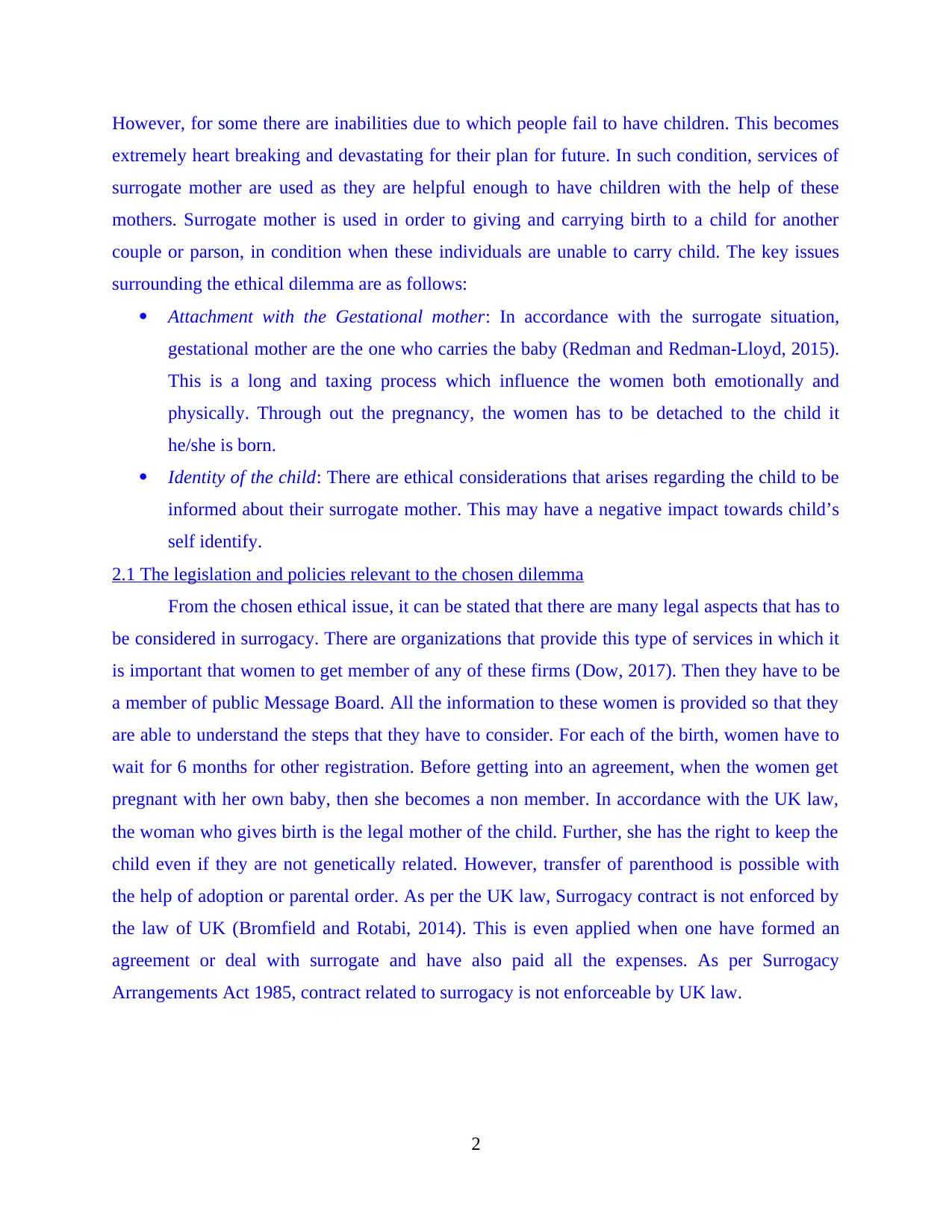
However, for some there are inabilities due to which people fail to have children. This becomes
extremely heart breaking and devastating for their plan for future. In such condition, services of
surrogate mother are used as they are helpful enough to have children with the help of these
mothers. Surrogate mother is used in order to giving and carrying birth to a child for another
couple or parson, in condition when these individuals are unable to carry child. The key issues
surrounding the ethical dilemma are as follows:
Attachment with the Gestational mother: In accordance with the surrogate situation,
gestational mother are the one who carries the baby (Redman and Redman-Lloyd, 2015).
This is a long and taxing process which influence the women both emotionally and
physically. Through out the pregnancy, the women has to be detached to the child it
he/she is born.
Identity of the child: There are ethical considerations that arises regarding the child to be
informed about their surrogate mother. This may have a negative impact towards child’s
self identify.
2.1 The legislation and policies relevant to the chosen dilemma
From the chosen ethical issue, it can be stated that there are many legal aspects that has to
be considered in surrogacy. There are organizations that provide this type of services in which it
is important that women to get member of any of these firms (Dow, 2017). Then they have to be
a member of public Message Board. All the information to these women is provided so that they
are able to understand the steps that they have to consider. For each of the birth, women have to
wait for 6 months for other registration. Before getting into an agreement, when the women get
pregnant with her own baby, then she becomes a non member. In accordance with the UK law,
the woman who gives birth is the legal mother of the child. Further, she has the right to keep the
child even if they are not genetically related. However, transfer of parenthood is possible with
the help of adoption or parental order. As per the UK law, Surrogacy contract is not enforced by
the law of UK (Bromfield and Rotabi, 2014). This is even applied when one have formed an
agreement or deal with surrogate and have also paid all the expenses. As per Surrogacy
Arrangements Act 1985, contract related to surrogacy is not enforceable by UK law.
2
extremely heart breaking and devastating for their plan for future. In such condition, services of
surrogate mother are used as they are helpful enough to have children with the help of these
mothers. Surrogate mother is used in order to giving and carrying birth to a child for another
couple or parson, in condition when these individuals are unable to carry child. The key issues
surrounding the ethical dilemma are as follows:
Attachment with the Gestational mother: In accordance with the surrogate situation,
gestational mother are the one who carries the baby (Redman and Redman-Lloyd, 2015).
This is a long and taxing process which influence the women both emotionally and
physically. Through out the pregnancy, the women has to be detached to the child it
he/she is born.
Identity of the child: There are ethical considerations that arises regarding the child to be
informed about their surrogate mother. This may have a negative impact towards child’s
self identify.
2.1 The legislation and policies relevant to the chosen dilemma
From the chosen ethical issue, it can be stated that there are many legal aspects that has to
be considered in surrogacy. There are organizations that provide this type of services in which it
is important that women to get member of any of these firms (Dow, 2017). Then they have to be
a member of public Message Board. All the information to these women is provided so that they
are able to understand the steps that they have to consider. For each of the birth, women have to
wait for 6 months for other registration. Before getting into an agreement, when the women get
pregnant with her own baby, then she becomes a non member. In accordance with the UK law,
the woman who gives birth is the legal mother of the child. Further, she has the right to keep the
child even if they are not genetically related. However, transfer of parenthood is possible with
the help of adoption or parental order. As per the UK law, Surrogacy contract is not enforced by
the law of UK (Bromfield and Rotabi, 2014). This is even applied when one have formed an
agreement or deal with surrogate and have also paid all the expenses. As per Surrogacy
Arrangements Act 1985, contract related to surrogacy is not enforceable by UK law.
2
Paraphrase This Document
Need a fresh take? Get an instant paraphrase of this document with our AI Paraphraser
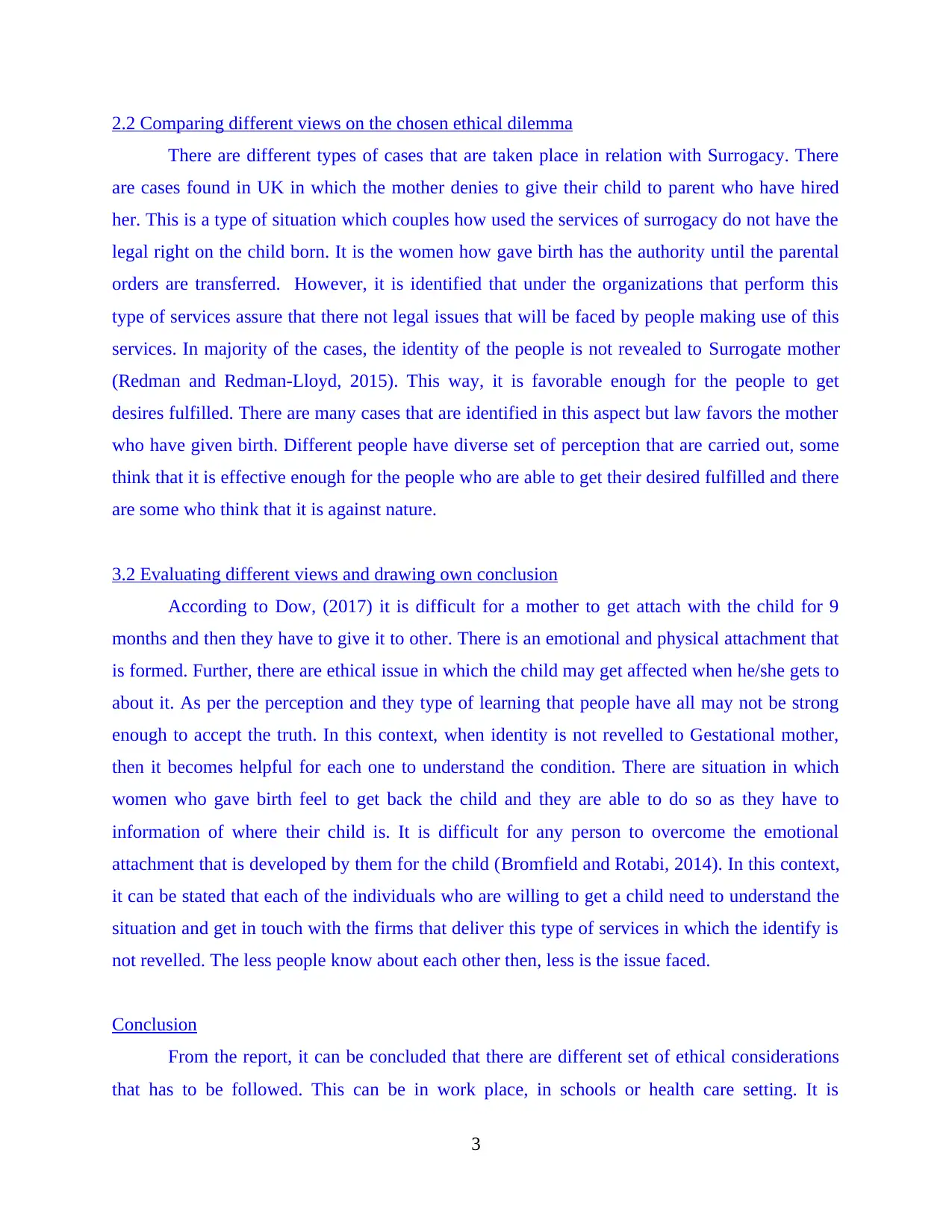
2.2 Comparing different views on the chosen ethical dilemma
There are different types of cases that are taken place in relation with Surrogacy. There
are cases found in UK in which the mother denies to give their child to parent who have hired
her. This is a type of situation which couples how used the services of surrogacy do not have the
legal right on the child born. It is the women how gave birth has the authority until the parental
orders are transferred. However, it is identified that under the organizations that perform this
type of services assure that there not legal issues that will be faced by people making use of this
services. In majority of the cases, the identity of the people is not revealed to Surrogate mother
(Redman and Redman-Lloyd, 2015). This way, it is favorable enough for the people to get
desires fulfilled. There are many cases that are identified in this aspect but law favors the mother
who have given birth. Different people have diverse set of perception that are carried out, some
think that it is effective enough for the people who are able to get their desired fulfilled and there
are some who think that it is against nature.
3.2 Evaluating different views and drawing own conclusion
According to Dow, (2017) it is difficult for a mother to get attach with the child for 9
months and then they have to give it to other. There is an emotional and physical attachment that
is formed. Further, there are ethical issue in which the child may get affected when he/she gets to
about it. As per the perception and they type of learning that people have all may not be strong
enough to accept the truth. In this context, when identity is not revelled to Gestational mother,
then it becomes helpful for each one to understand the condition. There are situation in which
women who gave birth feel to get back the child and they are able to do so as they have to
information of where their child is. It is difficult for any person to overcome the emotional
attachment that is developed by them for the child (Bromfield and Rotabi, 2014). In this context,
it can be stated that each of the individuals who are willing to get a child need to understand the
situation and get in touch with the firms that deliver this type of services in which the identify is
not revelled. The less people know about each other then, less is the issue faced.
Conclusion
From the report, it can be concluded that there are different set of ethical considerations
that has to be followed. This can be in work place, in schools or health care setting. It is
3
There are different types of cases that are taken place in relation with Surrogacy. There
are cases found in UK in which the mother denies to give their child to parent who have hired
her. This is a type of situation which couples how used the services of surrogacy do not have the
legal right on the child born. It is the women how gave birth has the authority until the parental
orders are transferred. However, it is identified that under the organizations that perform this
type of services assure that there not legal issues that will be faced by people making use of this
services. In majority of the cases, the identity of the people is not revealed to Surrogate mother
(Redman and Redman-Lloyd, 2015). This way, it is favorable enough for the people to get
desires fulfilled. There are many cases that are identified in this aspect but law favors the mother
who have given birth. Different people have diverse set of perception that are carried out, some
think that it is effective enough for the people who are able to get their desired fulfilled and there
are some who think that it is against nature.
3.2 Evaluating different views and drawing own conclusion
According to Dow, (2017) it is difficult for a mother to get attach with the child for 9
months and then they have to give it to other. There is an emotional and physical attachment that
is formed. Further, there are ethical issue in which the child may get affected when he/she gets to
about it. As per the perception and they type of learning that people have all may not be strong
enough to accept the truth. In this context, when identity is not revelled to Gestational mother,
then it becomes helpful for each one to understand the condition. There are situation in which
women who gave birth feel to get back the child and they are able to do so as they have to
information of where their child is. It is difficult for any person to overcome the emotional
attachment that is developed by them for the child (Bromfield and Rotabi, 2014). In this context,
it can be stated that each of the individuals who are willing to get a child need to understand the
situation and get in touch with the firms that deliver this type of services in which the identify is
not revelled. The less people know about each other then, less is the issue faced.
Conclusion
From the report, it can be concluded that there are different set of ethical considerations
that has to be followed. This can be in work place, in schools or health care setting. It is
3

identified with time, there are many advancement that has taken place and this is also helped to
fulfil their requirements. There are ethical issues that has also raised and it is important to take up
appropriate steps for the same.
4
fulfil their requirements. There are ethical issues that has also raised and it is important to take up
appropriate steps for the same.
4
⊘ This is a preview!⊘
Do you want full access?
Subscribe today to unlock all pages.

Trusted by 1+ million students worldwide
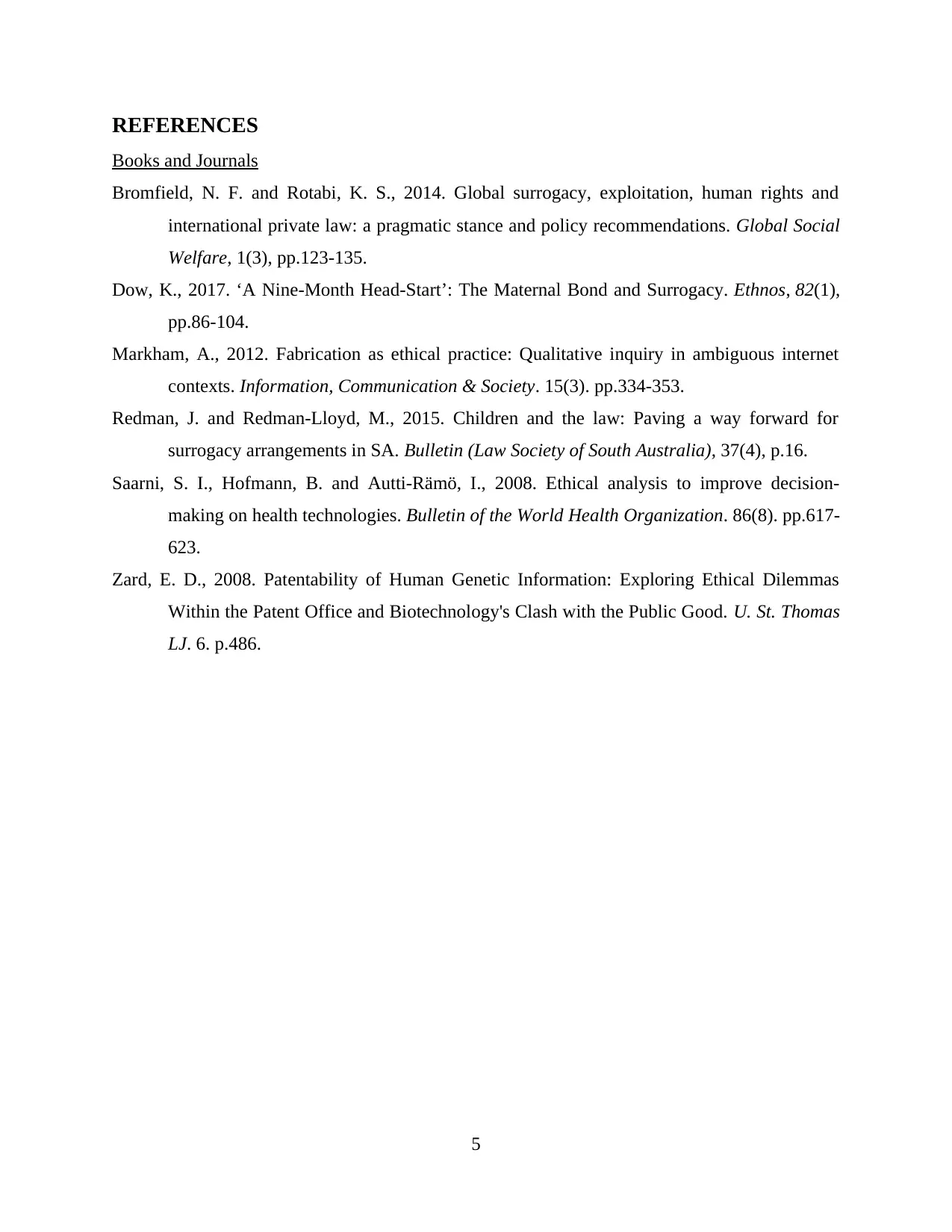
REFERENCES
Books and Journals
Bromfield, N. F. and Rotabi, K. S., 2014. Global surrogacy, exploitation, human rights and
international private law: a pragmatic stance and policy recommendations. Global Social
Welfare, 1(3), pp.123-135.
Dow, K., 2017. ‘A Nine-Month Head-Start’: The Maternal Bond and Surrogacy. Ethnos, 82(1),
pp.86-104.
Markham, A., 2012. Fabrication as ethical practice: Qualitative inquiry in ambiguous internet
contexts. Information, Communication & Society. 15(3). pp.334-353.
Redman, J. and Redman-Lloyd, M., 2015. Children and the law: Paving a way forward for
surrogacy arrangements in SA. Bulletin (Law Society of South Australia), 37(4), p.16.
Saarni, S. I., Hofmann, B. and Autti-Rämö, I., 2008. Ethical analysis to improve decision-
making on health technologies. Bulletin of the World Health Organization. 86(8). pp.617-
623.
Zard, E. D., 2008. Patentability of Human Genetic Information: Exploring Ethical Dilemmas
Within the Patent Office and Biotechnology's Clash with the Public Good. U. St. Thomas
LJ. 6. p.486.
5
Books and Journals
Bromfield, N. F. and Rotabi, K. S., 2014. Global surrogacy, exploitation, human rights and
international private law: a pragmatic stance and policy recommendations. Global Social
Welfare, 1(3), pp.123-135.
Dow, K., 2017. ‘A Nine-Month Head-Start’: The Maternal Bond and Surrogacy. Ethnos, 82(1),
pp.86-104.
Markham, A., 2012. Fabrication as ethical practice: Qualitative inquiry in ambiguous internet
contexts. Information, Communication & Society. 15(3). pp.334-353.
Redman, J. and Redman-Lloyd, M., 2015. Children and the law: Paving a way forward for
surrogacy arrangements in SA. Bulletin (Law Society of South Australia), 37(4), p.16.
Saarni, S. I., Hofmann, B. and Autti-Rämö, I., 2008. Ethical analysis to improve decision-
making on health technologies. Bulletin of the World Health Organization. 86(8). pp.617-
623.
Zard, E. D., 2008. Patentability of Human Genetic Information: Exploring Ethical Dilemmas
Within the Patent Office and Biotechnology's Clash with the Public Good. U. St. Thomas
LJ. 6. p.486.
5
1 out of 7
Related Documents
Your All-in-One AI-Powered Toolkit for Academic Success.
+13062052269
info@desklib.com
Available 24*7 on WhatsApp / Email
![[object Object]](/_next/static/media/star-bottom.7253800d.svg)
Unlock your academic potential
Copyright © 2020–2025 A2Z Services. All Rights Reserved. Developed and managed by ZUCOL.




